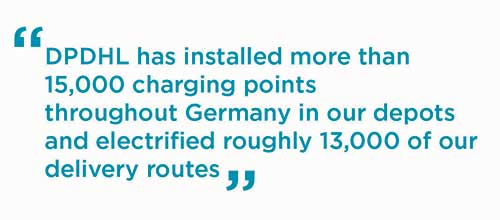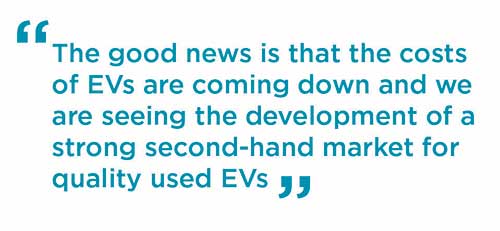The European Commission published a new clean-energy strategy in October, aimed specifically at upgrading buildings. But the automotive industry has its part to play in the strategy. Will it surf this renovation wave, or will it be left adrift? To find out, Autovista Group Daily Brief journalist Tom Geggus, spoke with electricity industry association, Eurelectric.

‘The renovation wave is a very necessary and a very timely initiative from the European Commission to tackle what is basically one of the largest remaining challenges in decarbonising the European economy, and that is buildings,’ explained Henning Hader, policy director at Eurelectric.
However, the wave is not focused solely on how efficiently a building uses energy, during heating or cooling for example. This process is just as much about future-proofing buildings for developments in smart technology, integration into digital infrastructure, and most importantly for the automotive industry, connection to advanced charging points.
Automotive application
‘The automotive sector is impacted across the entire value chain with this transformation,’ Hader emphasised. ‘They are being put under pressure, and rightly so, to come with products that are decarbonised, that enable people to switch to clean-energy carriers, using cars.’ This includes zero- and low-emission vehicles with electrified powertrains, i.e. battery-electric vehicles (BEVs) and plug-in hybrids (PHEVs).
In order to fully commit to decarbonisation, there must be enough demand for electrically-rechargeable vehicles (EVs). In the wake of coronavirus (COVID-19), governments are pushing incentive schemes to help the automotive industry make a green recovery, but these vehicles require charging and cannot exist in an infrastructure vacuum.
‘We know that cars are parked for 90 to 95% of their life, and 90% of that time they are parked at home or at work, in buildings, around buildings, under buildings, on top of buildings,’ said Hader. ‘So, what is important, is that chargers on private property, do not just appear out of nowhere. They have to be purchased and installed by the people who operate these buildings.’
This is where the renovation wave sweeps in, helping develop regulations, shaping what an updated structure should look like. Therefore, owners and operators of buildings need to be familiar with the opportunities this presents and even, ideally, be incentivised to anticipate this, allowing them to equip essential infrastructure.
The issue of availability
‘One of the biggest issues is the availability of charging points. We have lots of promising announcements about how the number of charging points is increasing, but most of those are public charging points,’ Hader stressed. The opportunity to install EV infrastructure has to be taken during a building’s renovation, even if the actual recharging system is not installed straight away. If the policy exists, all private and public properties would all be equipped for an upgrade, removing the potential for expensive retroactive installations.
‘These chargers enable us and our system operators, specifically distribution system operators, to take on all these cars that are charging in different areas, and when they are on smart chargers, they can become a flexibility source of the future,’ Hader explained.
This will be vital as cars adapt charging schedules, and even, under the right circumstances, feed into the grid. ‘There is an entire world of flexibility and efficiency that opens up if we make sure that renovating a building is about more than just insulation,’ he said. ‘It really is about getting the buildings to become a building block in the future energy system, where the buildings, the cars on those buildings and the people in these buildings, become very important flexibility providers.’ But, in order for this to happen, some current policies will require renovation.
Renewable energy directive
At its core, the EU’s renewable energy directive (RED) acts as a foundational policy for the production and promotion of energy from renewable sources. ‘There are elements in the renewable energy directive that are very relevant for electrification, and for electricity being used in transport, for example,’ Hader said. But, as part of the European Green Deal, this legislation, alongside the energy efficiency directive, is under review. Renewable-energy targets will be assessed, as well as other parts of the directive to fall in line with the Climate Target Plan for 2030. The results of the review and any accompanying proposals are expected in June 2021.
‘In order for the power sector to supply enough clean electricity to electrify the sectors that should be electrified, so, economically speaking, large parts of personalised passenger transport, heating to a large extent, some industrial processes, we will need to have a lot more capacity, specifically, of course, renewable capacity, because we want to fully decarbonise our sector’ he explained.
Therefore, RED will need to accelerate capacity rollout, particularly as it plays a fundamental role in helping build investor confidence in renewables. ‘In order to meet the new ambitious targets for 2030, and to decarbonise the power sector and to electrify large parts of society at the same time, we need more, we simply need more’ Hader said. Eurelectric’s Power Barometer reflects the developments the power sector is undergoing, as well as the challenges which lie ahead.
Source: Eurelectric
Knowledge is key
So, what barriers stand in the way of an automotive renovation wave? A chief issue to overcome is making sure both building owners and industry experts are aware of the new technological possibilities. This means supplying information across the renovation chain.
Proprietors need to be aware of the infrastructure potential, the experts offering advice to them must understand what technological and funding opportunities exist, and those carrying out the renovation work must have the practical skills to set up the technology. In this way, all necessary regulations can be adhered to, incentives taken advantage of, and infrastructure either installed or the framework set up for it.
This approach could help combat the rollout of soon-to-be-obsolete charging systems, only installed to meet immediate demand, but without any foresight of future smart-charging systems that are capable of cross-grid communication. But why is this type of connection important when it comes to EV infrastructure?
‘Let’s say you’re in a suburb of Brussels, and there is a system constraint because a lot of demand is coming online at the same time, and there is a need for flexibility so the operator can interact and communicate with these chargers,’ Hader explained. This could allow the grid operator to switch the role of the chargers and instead feed into the grid for a few minutes, with the consent of the EV owner.
But, the future of these systems depends upon the renovations that are carried out now. Even if they only consist of some basic piping, which could one day support smart, flexible and advanced EV charging technology.

 Schließen
Schließen











